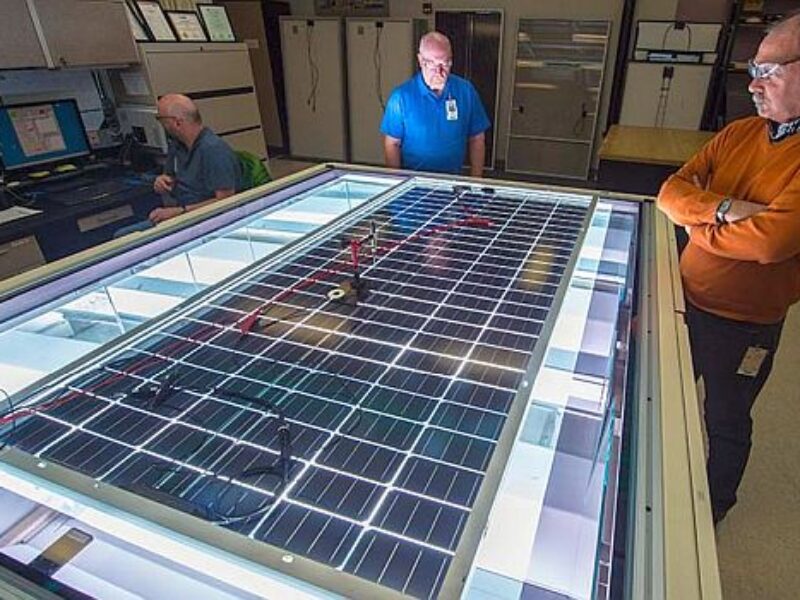
NREL slashes uncertainty rate for PV power measurement
This compares to a 0.4% tolerance on measurement of primary reference cells and 0.6% for secondary reference cells at NREL.
“This is over a $30 billion industry now,” said Keith Emery, a consultant to the U.S. Department of Energy’s (DOE’s) ) and, before he retired in 2016, the point person for the laboratory’s work to measure the efficiency of PV technology. “That $30 billion industry is weighted in units of watts, so a 1% uncertainty in a $30 billion industry is a big deal.”
“Manufacturers need some kind of yardstick at the end of their production line because they’re cranking out thousands of modules a day,” said Dean Levi, Emery’s successor and manager of the Cell and Module Performance group in the National Center for Photovoltaics at NREL.
Manufacturers price PV modules based on watts generated and typically provide a power tolerance of -0% to +3%. This means a 300W solar module, which sells for 30 cents per watt on the global wholesale market, has a margin of error for this module equates to 9W.
“Because of the way PV modules are rated for power, there’s a pretty good chance they’re selling you a 309-watt module for the price of a 300-watt module—and they don’t like that,” said Levi. “Manufacturers have been pushing for a long time for labs like ours to reduce our uncertainties because then they don’t have to sell a 309-watt module for the price of 300 watts. If their uncertainty is plus or minus 1%, they can instead sell that 309-watt module as a 306-watt module, so they’ve made that much more money.”
Although that only amounts to $1.80 more per module, large PV manufacturers produce more than 30 million 300-watt modules per year, so this small reduction in uncertainty can result in a $50 million improvement in annual revenues, he says.
To ensure proper calibration, manufacturers usually send at least two modules of the same model type to NREL’s South Table Mountain Campus in Golden, Colorado, as golden samples. There, the output performance of each is measured and the laboratory certifies that the module produces, for example, 302 watts, plus or minus 1.1%.
Back at the factory, the modules are used to check that output against the company’s solar simulator, which is essentially a large table that illuminates the module with light approximating sunlight.
“One of the biggest uncertainties in measuring power output is how accurately can you measure the light output of your simulator,” said Levi. “With this golden module, the manufacturer can set the light output of their simulator very accurately. Then they put that module in a safe place and they get out another module, just like the first one. They measure that module on the simulator and that’s their ‘silver module.’ That one they’ll use every morning, or maybe several times a day, to set the intensity of their simulator.”
“The simulator sits at the end of the production line,” Levi continued.” Every module that comes off the production line gets tested, and its power output gets assigned, based on that simulator—which is ultimately traceable back to our measurement of their module.”
The main work by Carl Osterwald, an NREL electrical engineer, and Larry Ottoson, a technician at the laboratory’s Outdoor Test Facility, reduced the margin of error by eliminating anything that was causing errors in the calibrations, such as eliminating light leaks. “Not any one of our systems by itself could get better than 2%,” said Osterwald. “So, we had to use a combination method. It was a combination of a whole bunch of things. We completely changed the calibration procedure for PV modules.”
One change considered the fact that light from a simulator isn’t uniform, something that can dominate the uncertainty. In the new procedure, the current produced by a module is first calibrated outdoors, which provides a very uniform light source. Then, that carefully calibrated module can be used as its own reference module for the other tests. After the current is measured outdoors, the module is put into a simulator and the light level is set correctly.
“With each of these, we became the lowest uncertainty in the world when we attained those accreditations,” said Levi.
“A lot of the PV power we get is from huge utility-scale power plants they build out in the desert or out in the plains,” he added. “Most of those are financed by banks, and banks don’t like risk. If a bank perceives more risk in a project, they’re going to charge a higher interest rate.”
“And that interest rate directly impacts the cost of the power that project produces. If the banks have a higher confidence in the energy output, then they’re going to charge a lower interest rate, and that’s one of the major factors that DOE has identified as a pathway to reduce the cost of solar energy: To reduce the perceived risk by the investors.”
 If you enjoyed this article, you will like the following ones: don't miss them by subscribing to :
eeNews on Google News
If you enjoyed this article, you will like the following ones: don't miss them by subscribing to :
eeNews on Google News




